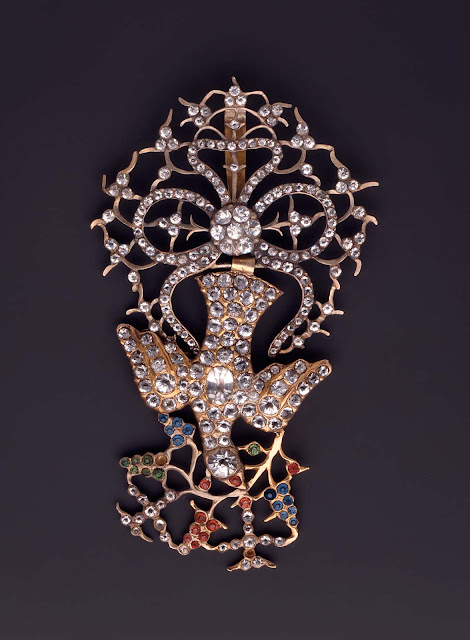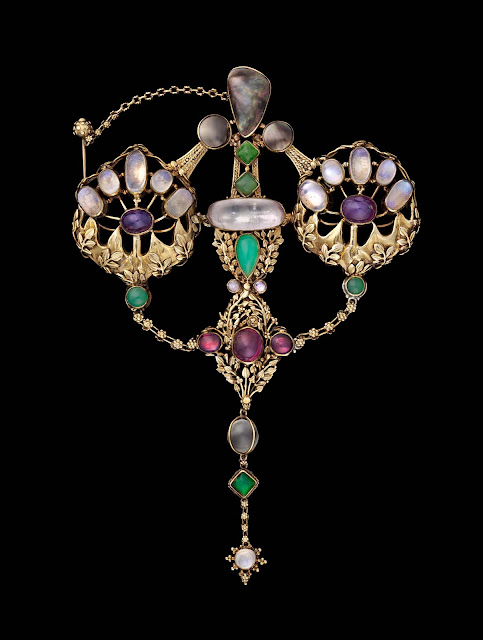 |
| Classical Greece Wreath with oak leaves and acorns 4th century BC gold Museum of Fine Arts, Boston |
"Two tubular branches (in semi-circular sections) are fastened to the front by a wire connecting the two looped ends. The oak leaves and acorns, veiled with gold leaf, are connected to the branches by gold wire stems."
 |
| Hellenistic Greece Necklace late 2nd - 1st century BC gold, amethysts, chalcedony, emeralds, rock crystal, pearl-colored glass Walters Art Museum, Baltimore |
"This necklace was found on the neck of the deceased. The butterfly pendant, as a symbol of the soul, was appropriate for a burial gift."
 |
| Byzantium Earrings AD 600 gold, pearls, semi-precious stones Walters Art Museum, Baltimore |
"These dramatic earrings were most likely made in Constantinople, perhaps as an imperial gift to a Visigothic ruler of early medieval Spain, where the pair were found. The Visigoths, a migratory group that ultimately settled in Spain, had by the 6th century established trade and diplomatic contacts with the Byzantine court, whose jewelry they much admired."
 |
| Anonymous European Jeweler Aglet ca. 1550-1650 enameled gold, with shell-cameo Walters Art Museum, Baltimore |
"Dress ornaments, or aglets, designed to be sewn onto clothing, were a common form of jewelry during the Renaissance. They were usually made of enameled gold and set with pearls, cameos, or precious stones. Set in gold enameled openwork, the cameo of this piece depicts a faun playing a pipe in a garden setting."
 |
| Anonymous Netherlandish Jeweler Pendant - Dolphin ca. 1600 enameled gold, emeralds, pearls Walters Art Museum, Baltimore |
"This flamboyant design is close to the model on the title page of the second part of Hans Collaert's series of pendant designs published in Antwerp in 1582, Virtuosic Designs for Golden Ornaments. In the engraving, it is the god Apollo riding a sea monster, but the similarities remain strong."
 |
| Anonymous German or Flemish Jeweler Pendant - Goddess Diana 16th century, with 19th-century restorations enameled gold, diamonds, rubies, pearls Walters Art Museum, Baltimore |
"This pendant features Diana, the Roman goddess of the hunt, accompanied by a dog and carrying her bow, quiver, and a horn. Analysis of the enamels confirmed a 16-century date for the figural group. However, the enameling on the mount proved to be of a later date. It is possible that the later elements on the mount are restorations made due to damage to the original enamel, which chips easily."
 |
| attributed to Ioseph Rosell Badge - Order of Santiago de Compostela ca. 1670-79 enameled gold, emeralds, diamonds Walters Art Museum, Baltimore |
"The religious Order Of St James (Sant Iago) was a military order established in 1171 at the pilgrimage cathedral of Santiago de Compostela in Spain to protect it from attacks by Muslims. Pilgrims to the church frequently ate scallops and attached the empty shells to their hats. Members of the order adopted the scallop as their badge."
 |
| Anonymous French Jeweler Pendant - L'Ordre du Saint-Esprit ca. 1780-90 gold, paste brilliants, rubies, emeralds, sapphires Museum of Fine Arts, Boston |
"The Order of the Holy Spirit (L'Ordre du Saint-Esprit) was created in France by Henri III in 1578. There were strict nobility requirements and membership was limited to 100. Four cardinals and four other prelates were members and were called commandeurs, the other members were called chevaliers. The King of France was the Sovereign and Grand Master and made all appointments to the order. It was abolished in 1790 during the French Revolution."
 |
| Anonymous Swiss Jeweler Watch ca. 1800-1825 enameled gold, silver gilt, pearls Walters Art Museum, Baltimore |
"For this peony-shaped watch, the gold case was first enameled in white. Next, colored enamel was fused over the top to create a naturalistic effect of unfurling petals, outlined in pearls. To represent green leaves at the base of the flower, another enameling technique called basse-taille was employed. Here, the gold was engraved to imitate veins that show through the translucent green enamel."
 |
| Pierre-Benjamin Tavernier Watch (montre à tact) ca. 1805-1809 guilloché gold, basse-taille enamel, pearls, diamonds Walters Art Museum, Baltimore |
"This unusual watch has no numbers. It belongs to a type called montres à tact or "discrete watches." The design allows the time to be told by touch alone, feeling the four diamonds on the hour and the quarters, and the pearls that mark the remaining divisions of the twelve hours. The raised arrow, also in diamonds, contrasts with the smooth surrounding enamel, taking the place of watch hands. It was made for Maria Letizia Bonaparte, Napoleon's mother, who lost her sight as she aged. The case employs a process called guilloché, whose subtle but kaleidoscopic effects are created through mechanical means. Geometric shapes are carved into metal by engine turning. The resulting patterns of fine lines are covered with transparent enamel. When light hits them it creates oscillating optic effects."
 |
| Fabergé Parasol Handle ca. 1900 enameled gold, diamonds Walters Art Museum, Baltimore |
"In this parasol handle the metal form was mechanically engraved with a ray pattern. Several coats of translucent pink enamel were then fired at very high temperatures, allowing the engraved pattern to shimmer through. . . . Before the last coat of enamel was applied, a design in imitation of moss agate was painted on. Diamonds alternate with red and white beads of enamel in imitation of pearls and uncut rubies."
 |
| René Lalique La Source - Pendant and Necklace ca. 1902 enameled gold, ivory, opals Walters Art Museum, Baltimore |
"As early as 1895 Lalique incorporated entire human figures into his designs. A partially draped female figure holding a pitcher carved of ivory is surrounded by wisteria vines with the stalks enameled in deep blue, leaves green, and blossoms opalescent white. Rounded pale orange Mexican opals are set in the vines above the figure's head on either side and below her feet. The chain is composed of blue enameled elongated links and gold rings."
 |
| René Lalique Orchid Comb ca. 1903-1904 enameled gold, ivory, horn, diamonds Walters Art Museum, Baltimore |
"Lalique revolutionized jewelry design in the final decade of the 19th century by combining materials in unexpected ways, developing new techniques, reviving old ones, and blending historical and cultural references to create new vocabularies and forms. The Orchid Comb showcases these innovations. Lalique's studio rendered the naturalistic orchid from a single piece of ivory. Diamonds play a supporting role, picking out the veins along three slim leaves in plique-à-jour enamel. The stem is attached by a gold hinge to a three-pronged horn comb. This is the most flamboyant of the pieces purchased by museum founder Henry Walters at the Saint Louis World's Fair in 1904. Never intended to be worn, it entered the collection as a masterpiece of technical accomplishment."
 |
| John Paul Cooper Brooch 1908 gold, abalone, tourmaline, moonstones, pearls, amethysts, chrysopane, jade Museum of Fine Arts, Boston |
"John Paul Cooper, a leading figure in the British Arts and Crafts movement, was an architect, designer, and metalsmith. Born into an affluent Leicester family, Cooper prepared for a career as a writer but was discouraged from pursuing this endeavor by his industrialist father. Instead, he apprenticed to London architect John D. Sedding, a strong proponent of the ideas of John Ruskin, and to Henry Wilson, an architect with interests in craft, especially metalwork and jewelry. . . . Cooper's interest in jewelry design and fabrication began shortly after his association with Wilson. Like Wilson, he eventually employed others to fabricate his jewelry designs, although he sometimes did the chasing and repoussé work himself. The jewelry was crafted primarily in 15 kt. gold, utilizing semi-precious cabochons (domed, unfaceted stones) and mother-of-pearl. . . . It took 273 hours to produce this brooch, and Lorenzo Colarosi, Cooper's chief craftsman, was the primary fabricator."
– texts based on curator's notes from the Walters Art Museum, Baltimore and the Museum of Fine Arts, Boston